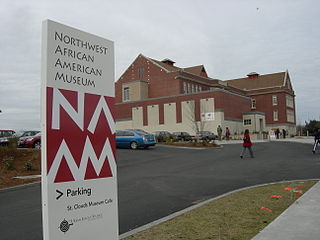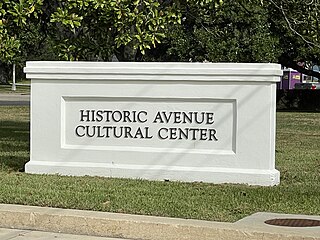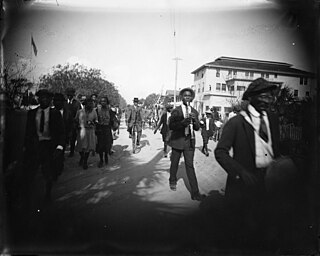
Charles Henry Alston was an American painter, sculptor, illustrator, muralist and teacher who lived and worked in the New York City neighborhood of Harlem. Alston was active in the Harlem Renaissance; Alston was the first African-American supervisor for the Works Progress Administration's Federal Art Project. Alston designed and painted murals at the Harlem Hospital and the Golden State Mutual Life Insurance Building. In 1990, Alston's bust of Martin Luther King Jr. became the first image of an African American displayed at the White House.

St. Augustine is a city in and the county seat of St. Johns County located 40 miles south of downtown Jacksonville. The city is on the Atlantic coast of northeastern Florida. Founded in 1565 by Spanish colonists, it is the oldest continuously inhabited European-established settlement in what is now the contiguous United States.
David Nolan is an American author, civil rights activist, and historian.

The Charles H. Wright Museum of African American History is a museum of African-American history and culture, located in Detroit, Michigan. Located in the city's Midtown Cultural Center, The Wright is one of the world's oldest and largest independent African-American museums, holding the world's largest permanent collection of African-American culture. With a collection of more than 35,000 artifacts, The Wright's current 125,000-square-foot museum opened as the largest museum in the world dedicated to African-American history.

Lincolnville Historic District is a neighborhood in St. Augustine, Florida established by freedmen following the American Civil War and located on the southwest peninsula of the "nation's oldest city." It was designated as an historic district in 1991 and listed on the National Register of Historic Places. Originally recorded with 548 contributing buildings, the district is bounded by Cedar, Riberia, Cerro and Washington streets and DeSoto Place.

Barry Farm is a neighborhood in Southeast Washington, D.C., located east of the Anacostia River and bounded by the Southeast Freeway to the northwest, Suitland Parkway to the northeast and east, and St. Elizabeths Hospital to the south. The neighborhood was renowned as a significant post-Civil-War settlement of free Blacks and freed slaves established by the Freedmen's Bureau. The streets were named to commemorate the Union generals, Radical Republicans, and Freedmen's Bureau officials who advanced the rights of Black Americans during the Civil War and Reconstruction: Howard Road SE for General Oliver O. Howard; Sumner Road SE for Massachusetts Senator Charles Sumner; Wade Road SE for Ohio Senator Benjamin Wade; Pomeroy Road SE for Kansas Senator Samuel C. Pomeroy; Stevens Road SE for Pennsylvania Congressman Thaddeus Stevens, and Nichols Avenue for Henry Nichols who was the first superintendent of Saint Elizabeth's Hospital. The neighborhood name is not a reference to the late former mayor of Washington, D.C., Marion Barry, but coincidentally has the same spelling.

African American Museum in Cleveland, Ohio was founded in 1953 by Icabod Flewellen. The Museum is housed in a 100-year-old Carnegie Library building. The Museum works to educate young people about the positive contributions of blacks to the cultures of the world, and to eliminate the distorted portrayals and images of black people.

The Northwest African American Museum (NAAM) serves to present and preserve the connections between the Pacific Northwest and people of African descent and investigate and celebrate Black experiences in America through exhibitions, programs and events. The museum is located in Seattle, Washington's historically African-American Central District neighborhood in the former Colman School, with official status as a City of Seattle landmark. The building also contains 36 units of affordable housing.

The architecturally and historically significant Historic Avenue Cultural Center is an exhibit and event space that serves as an anchor to Mobile, Alabama’s budding Civil Rights and Cultural Heritage District. From the early 1990s to approximately 2015, it served as the National African American Archives and Museum. Formerly known as the Davis Avenue Branch of Mobile Public Library, it was the lone Black library in Mobile County during segregation.

Louisiana African American Heritage Trail is a cultural heritage trail with 38 sites designated by the state of Louisiana, from New Orleans along the Mississippi River to Baton Rouge and Shreveport, with sites in small towns and plantations also included. In New Orleans several sites are within a walking area. Auto travel is required to reach sites outside the city.

The St. Augustine movement was a part of the wider Civil Rights Movement, taking place in St. Augustine, Florida from 1963 to 1964. It was a major event in the city's long history and had a role in the passage of the Civil Rights Act of 1964.
Education in Jacksonville, Florida is available through both public and private sources.

St. Benedict the Moor School is a former Black Catholic primary school located in the Lincolnville Historic District of St. Augustine, Florida. The school is a contributing property of the Lincolnville Historic District on the National Register of Historic Places.
The history of the 1954 to 1968 American civil rights movement has been depicted and documented in film, song, theater, television, and the visual arts. These presentations add to and maintain cultural awareness and understanding of the goals, tactics, and accomplishments of the people who organized and participated in this nonviolent movement.
St. Augustine, Florida, the oldest continuously occupied settlement of European origin in the continental United States, was founded in 1565 by Spanish admiral Pedro Menéndez de Avilés. The Spanish Crown issued an asiento to Menéndez, signed by King Philip II on March 20, 1565, granting him various titles, including that of adelantado of Florida, and expansive privileges to exploit the lands in the vast territory of Spanish Florida, called La Florida by the Spaniards. This contract directed Menéndez to explore the region's Atlantic coast and report on its features, with the object of finding a suitable location to establish a permanent colony from which the Spanish treasure fleet could be defended and Spain's claimed territories in North America protected against incursions by other European powers.
Fred A Henderich was a leading architect of the Florida land boom of the 1920s. He was a native of New York and graduated from Columbia University. Henderich came to Saint Augustine in 1905 to work for Henry Flagler's Florida East Coast Hotel Company and lived and worked in the city for over twenty years.

The 1964 Monson Motor Lodge protest was part of a series of events during the civil rights movement in the United States which occurred on June 18, 1964, at the Monson Motor Lodge in St. Augustine, Florida. The campaign between June and July 1964 was led by Robert Hayling, Martin Luther King Jr., Ralph Abernathy, Andrew Young, Hosea Williams, C. T. Vivian and Fred Shuttlesworth, among others. St. Augustine was chosen to be the next battleground against racial segregation on account of it being both highly racist yet also relying heavily on the northern tourism dollar. Furthermore, the city was due to celebrate its 400th anniversary the following year, which would heighten the campaign's profile even more. Nightly marches to the slave market were organized; marchers were regularly attacked and beaten.

Frank Bertran Butler (1885–1973) was an American businessman who established a beach resort for African Americans in northeast Florida during the segregation era. He worked in Fernandina Beach, St. Augustine, and then St. Augustine's Lincolnville neighborhood where he established his own market as well as a real estate business. He acquired land on Anastasia Island stretching between the Atlantic Ocean and the Matanzas River on which he established a beach area resort open to African Americans. The Tampa Times reported it to be the only beach open to them between the Jacksonville area and Daytona Beach during segregation. It became known as Butler Beach. The unincorporated community and a park in it are named for him.

Richard Aloysius Twine was a professional photographer in the Lincolnville section of St. Augustine, Florida in the 1920s.














